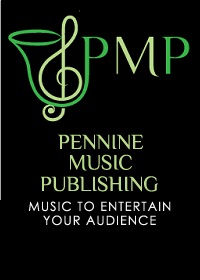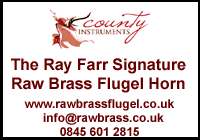Perfect Percussion - Building the complete section
11-Jun-2008In the first of a new series, Dave Danford looks at how to build a percussion section that will do just the right job for you.
Introduction:
Choosing which percussion instruments to buy can be a daunting task for any band. There's a seemingly endless list of manufacturers and options within each of their ranges.
In this series of articles I'll be talking about the instruments I've had positive experiences with and reviewing a number of popular models from each of the main categories:
· THE BASICS - Bass Drum, Snare Drum and Cymbals
· TUNED PERCUSSION - including Glockenspiel, Xylophone and Vibraphone
· UNPITCHED PERCUSSION - including Tambourine, Triangle and Wood Block
· TIMPANI
· RHYTHM PERCUSSION – including Drum Kit
· STICKS AND MALLETS
The Basics:
The foundations of the percussion section in any brass band are the three instruments that were first allowed to be used in contests, in the days when percussion was very much considered an optional extra; bass drum, snare drum and clash cymbals.
These three instruments are almost guaranteed to be used in every rehearsal and concert so it's important to invest strongly in this area. A tam-tam has also become a standard part of the brass band set up so we'll include something about them here too.
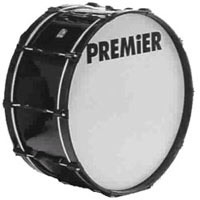 a) Bass Drum
a) Bass Drum
The standard size of bass drum most suitable for general brass band use is between 32" and 36". Manufacturers to look for include Adams, Premier and Yamaha.
There are two options when it comes to mounting your bass drum. The less expensive option is a height adjustable cradle that the bass drum is rested on top of, either upright or on its side. Available for slightly more money is a fully adjustable, rotating cradle. This option is ideal as the bass drum can be rotated to any playing angle, and this can be done in seconds, even during pieces.
Review: Adams Concert Bass Drum
The Adams concert bass drum is available in four different sizes; 28”, 32”, 36” and 40”. For brass band use it’s best to stick to the 32” and 36” models.
The 28” is simply too small for use as the main bass drum in contemporary brass band music, whereas the 40” would cause more logistical problems than it’s worth. There are two different stands to choose from; a standard tilting stand and a free suspended ring stand.
Although the ring stand claims to aid the resonance of the drum, the standard tilting stand allows a much more convenient playing position, especially when the drum is being used horizontally. These drums produce a strong sound, with a deep low-end, and they’re particularly clear rhythmically, partly thanks to the Remo Fiberskyn III heads, which are supplied as standard.
Review: Premier Orchestral Bass Drum
Premier’s orchestral bass drum is currently available in one size: 36” x 16”. As limiting as this may sound, they’ve really got the balance right sound-wise.
The drum has a stunning deep sound, perfect for rolls and big single notes. The two stands available from Premier are a cradle (limited to vertical or horizontal mounting only) and a trolley. Sadly the current trolley just isn’t up to the task; it’s far too lightweight compared to the drum.
Thankfully, Premier have recently struck a deal with Kolberg Percussion in Germany to manufacturer a better one which should be available towards the end of 2008. It is possible to get the drum adapted for use with an Adams bass drum cradle, which is definitely an option worth looking at, especially with the drum itself being of such high quality.
Cases
Concert bass drums are heavy enough without the added weight of a case so it’s best to stick to covers or soft gig bag type cases rather than hard plastic ones.
Mushroom Covers have two of the better options available; a standard cover suitable for dropping over the whole instrument whilst it is mounted on a trolley-type stand, and a dual purpose bag that uses zips and openings to allow the instrument to be taken on and off the stand whilst in the bag. Premier have a gig bag available specifically designed for their bass drum.
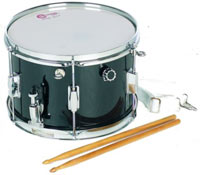 b) Snare Drum
b) Snare Drum
There’s a huge range of snare drums available from literally hundreds of manufacturers.
The standard diameter is 14” with the standard depth being between 5” and 7”. Very often bands won’t have sufficient funding available to buy a concert snare drum in addition to the one supplied with the drum kit.
Consequently when buying a drum kit it’s important to consider that the snare drum supplied it may end up being used more than any other instrument in your percussion section.
If you are intending on buying a separate concert snare drum then look out for some of the following:
Grover Projection-Plus
Pearl Masters Symphonic
Puresound Brass Ultrasonic Custom
Premier Modern Classic
Tama Starclassic
Yamaha Grand Concert
Stands
A tall orchestral-type snare drum stand is essential for brass band playing, even if you are using the same drum on the kit for other pieces. Premier have two models available, both of which are ideal for brass band use.
Cases
The range of snare drum cases available from Hardcase are ideal for all brass band applications. Protection Racket make a quality range of padded soft cases that are very close in price to the Hardcase equivalents but it’s well worth investing in hard-type cases if your percussion instruments are regularly being taken out of the bandroom.
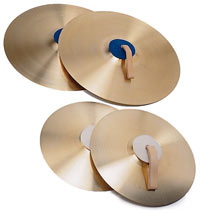 c) Cymbals
c) Cymbals
Brass bands can be loud and you need cymbals that can compete with that volume, as well as also being capable of cutting through.
This means you need instruments that are medium to bright in pitch, have a reasonable amount of sustain and have a definite and reasonably quick start to their sound.
Thin, light (French) pairs are the least suitable for this application. They maybe easy to play (being physically lighter) but they have little sustain and although the sound produced will be pleasing to the player it will not carry through the band and into the audience.
If marching is a significant part of the band’s performing calendar then a second smaller pair of clash cymbals would be a worthwhile investment. Marching for any length of time (Whit Friday anyone?) with anything bigger than 16” or 17” cymbals will be tiring.
Having a second pair also gives the players another sound option to use in concert performances rather than using a single pair all the time – cornet players carry more than one type of mute, for example.
The three main manufacturers to look out for are Paiste, Sabian and Zildjian. Sabian seem to have the lower-priced end of the scale wrapped up with their XS20 range. Unlike other semi-professional ranges, these cymbals are cast (the same method as top of the range cymbals) rather than cut from a sheet.
Recommendations:
Here are some personal recommendations, although it is important to remember that every player will have his or her own preference:
Youth Band – budget conscious
Clash cymbals (pairs):
16” Sabian XS20 concert band
18” Sabian XS20 concert band
One or the other, depending on the physical capabilities of the young players
14” Sabian XS20 concert band
This pair as a second pair for marching if needed
Suspended cymbals:
16” Sabian XS20 suspended
18” Sabian XS20 suspended
Both, if possible, but the 18” is first choice, with the 16” added when funds allow – these cymbals can also be used as kit cymbals
Youth Band – high-end
Clash cymbals (pairs):
18” Sabian HHX Synergy heavy
19” Sabian HHX Synergy medium
One or the other, depending on the physical capabilities of the young players
17” Sabian HHX Synergy heavy
This pair as a second pair for marching if needed
Suspended cymbals:
16” Sabian AA Molto suspended
18” Sabian AA Molto suspended
Both, if possible, but the 18” is first choice, with the 16” added when funds allow – these cymbals can also be used as kit cymbals
Senior Band – budget conscious
Clash cymbals (pairs):
20” Sabian XS20 concert band
16” Sabian XS20 concert band
20” is the main pair to buy; the 16” can be added as a second pair for marching if needed
Suspended cymbals:
18” Sabian XS20 suspended
20” Sabian XS20 suspended
Both, if possible, but the 20” is first choice, with the 18” added when funds allow – these cymbals can also be used as kit cymbals
Senior Band – high-end
Clash cymbals (pairs):
19” Sabian HHX Synergy medium
20” Sabian HHX Synergy medium
One or the other depending on physical preference
17” Sabian HHX Synergy heavy
This pair is great for marching as well as a second pair for concert performance
Suspended cymbals:
16” Sabian HHX suspended
18” Sabian AA Molto suspended
Both, if possible, but the 18” is first choice, with the 16” added when funds allow – these cymbals can also be used as kit cymbals
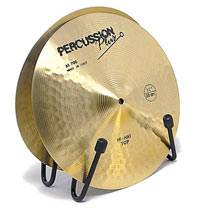 Stands
Stands
A cymbal cradle is a must and really needs to be purchased at the same time as the clash cymbals.
Balancing the cymbals on a chair may seem like a great way of saving money, but this won’t allow you to pick the cymbals up quickly, but them down quickly and there’s a big chance they’ll end up falling onto the floor sometime during a concert (usually the quietest moment!).
Premier have a good quality cymbal cradle available and Sabian make a special ‘Crash Caddy’ that can be wrapped around an orchestral music stand to become a cymbal cradle as well as doubling as a cymbal bag.
There are literally hundreds of suspended cymbal stands to choose from. The better models have double-braced legs for added stability and the manufacturers to look out for are Big Dog, Mapex, Pearl, Premier, Tama and Yamaha.
Cases
Protection Racket’s deluxe cymbal case is well padded and easy to carry. Le Blond make a very popular case for clash cymbals which is relatively low priced and strong. If your kit or clash cymbals are regularly taken out of the bandroom then it’s worth considering the Hardcase range, which offers complete protection and a lifetime guarantee.
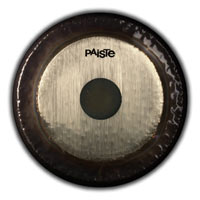 d) Tam-Tam / Gong
d) Tam-Tam / Gong
The tam-tam has become an integral part of the brass band percussion section and it is now rare to find a modern test-piece that excludes it from the instrument list.
The Paiste Symphonic gongs have become something of a standard choice but in recent years Sabian have won over many people with their Zodiac gongs, mostly due to their quality, ease of control and slightly lower price tag. For the more budget conscious Sabian also have a range of Symphonic gongs which are well under £400.
28” Sabian Symphonic Gong (around £350)
28” Sabian Zodiac Gong (around £500)
32” Paiste Symphonic Gong (around £700)
36” Paiste Symphonic Gong (around £1100)
Stands
Large ring-type stands are available with the Paiste symphonic gongs and although they dismantle easily for transport, it’s difficult to fully control the instrument during performances. The ideal stand is a low folding stand that keeps the instrument at a comfortable playing height, allows good access for control and will also fit into a standard 40” hardware case for transport.
Cases
Le Blond offer good tam-tam cases (available up to 34”) but it’s better to go for one of the soft cases available for ease of transporting and carrying. I can personally recommend GBz Cases or Mushroom Covers for this.
The Author:
Dave Danford is a freelance percussionist presenting solo recitals, masterclasses and sectionals as well as performing as a guest soloist with orchestras, wind orchestras and brass bands throughout the UK. Dave has been performing regularly with the Cory Band since 2004.








